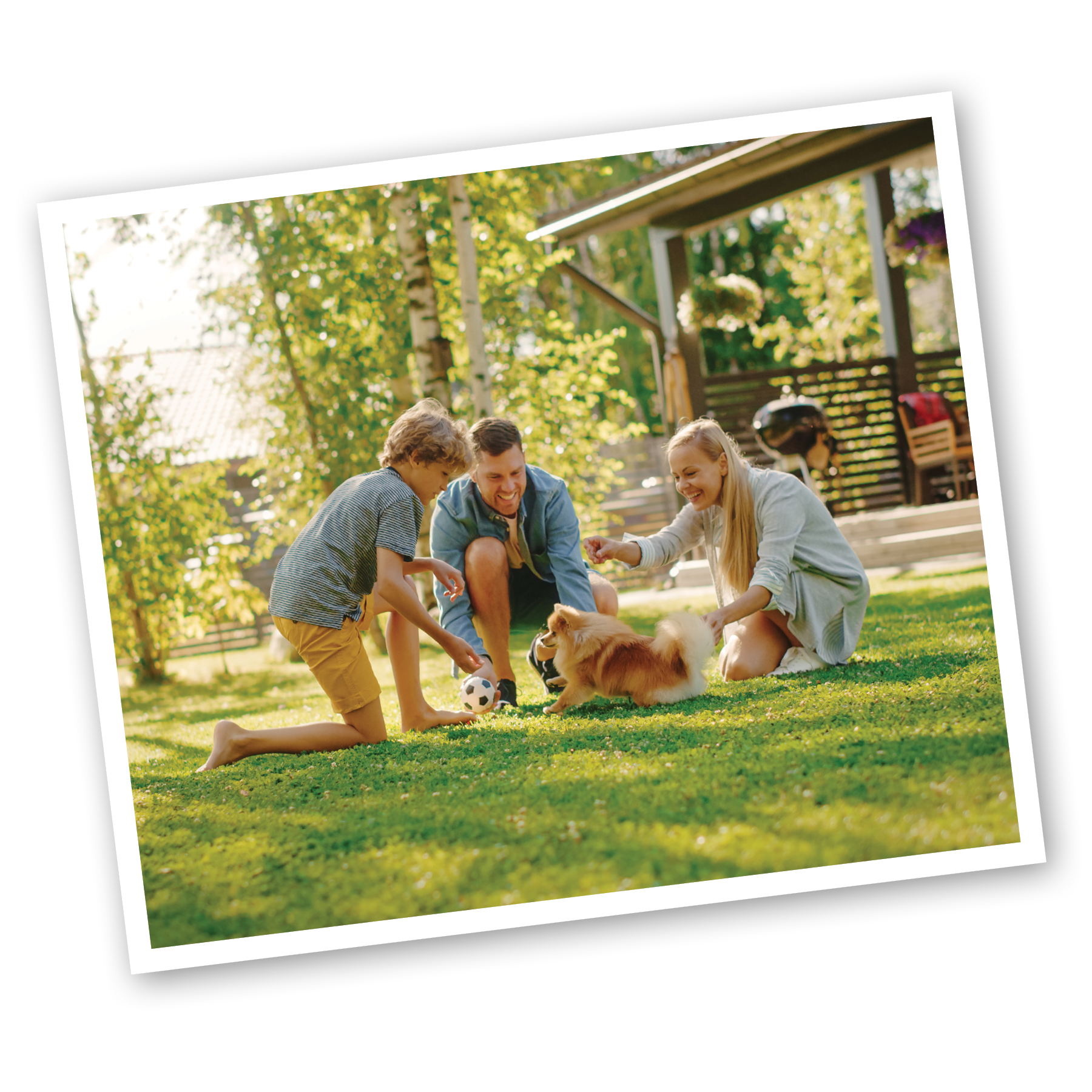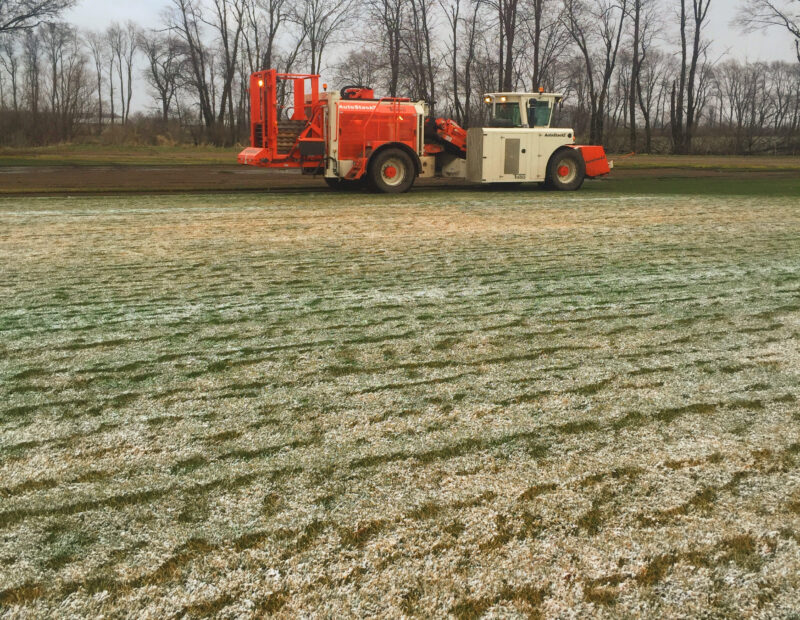No hassle. No nurturing. No wait. Sod is an instant lawn of lush, green turf.

You really can’t compare turf with seed or hydroseed. Sod is a mature, nurtured and developed plant. Seeds are exactly that–undeveloped, immature plants. It takes us a year or more to grow our seed into the lush, green carpeting that you’ll see immediately upon installation.
If you have children or pets, take our advice: install sod. Seed and hydroseed take so long to cover the mud, you’ll end up with half of your new lawn in your living room carpet before the end of the first year.
Have you ever seen the turquoise ribbons of chemicals left in the street by a hydroseeded lawn as it was washed away by a rainstorm? These trails of washouts make a lawn surface bumpy and inhospitable to future grass seed. Sodding helps to control erosion from the minute it is laid.
Since sod is a mature plant, it needs very little attention until it is a rooted– about two to four weeks after it is installed. Seed or hydroseed, however, will need your full attention for over a year– that is, assuming it does not wash out in the first big rain.
Weather affects the outcome of everything you do with grass. There are other considerations in growing a good lawn too–fertilizer, mowing height, etc. At Red Hen, we’re the experts, and we know it takes more than one lawn to gain the experience necessary to avoid mistakes in growing grass.
Water, herbicides, insecticides, fertilizer…all of these grass-growing aids cost money. And many novices will over-apply herbicides, fertilizer and other products while they learn, through trial and error, how to grow their lawn. Allowing professionals to take care of these initial applications will save you a fortune.
If your neighborhood had a BEST LAWN AWARD, would you be interested in winning? Choose from one of our two sod blends. Whether you select our Kentucky Bluegrass Sod or our Turf-type Tall Fescue Sod, both have been strategically blended with the top varieties of seeds to offer the best genetics possible.
Everyone agrees that minimizing the amount of chemicals in our lawns makes for a better environment. At Red Hen, we minimize the applications of herbicides, fungicides and other chemicals by taking advantage of our natural climate– cooler weather with early frosts. If you seed, you will likely need three or more applications of herbicides to keep the weeds from competing with the grass.
While you do not need excellent soils to grow sod, if you are beginning your lawn with seed, you will need top quality soils to start the plants off right. Fertilizer and water management become critical when you start from seed on poor soils. It takes more fertilizations to start seed, and it is a rare lawn service that will adjust to these conditions.
No hassle. No nurturing. No wait. Sod is an instant lawn of lush, green turf.
You’re an intelligent consumer. You want to understand both sides of a story before making a decision. You want to know the facts about sodding and hydroseeding.

You really can’t compare turf with seed or hydroseed. Sod is a mature, nurtured and developed plant. Seeds are exactly that–undeveloped, immature plants. It takes us a year or more to grow our seed into the lush, green carpeting that you’ll see immediately upon installation.
If you have children or pets, take our advice: install sod. Seed and hydroseed take so long to cover the mud, you’ll end up with half of your new lawn in your living room carpet before the end of the first year.
Have you ever seen the turquoise ribbons of chemicals left in the street by a hydroseeded lawn as it was washed away by a rainstorm? These trails of washouts make a lawn surface bumpy and inhospitable to future grass seed. Sodding helps to control erosion from the minute it is laid.
Since sod is a mature plant, it needs very little attention until it is a rooted– about two to four weeks after it is installed. Seed or hydroseed, however, will need your full attention for over a year– that is, assuming it does not wash out in the first big rain.
Weather affects the outcome of everything you do with grass. There are other considerations in growing a good lawn too–fertilizer, mowing height, etc. At Red Hen, we’re the experts, and we know it takes more than one lawn to gain the experience necessary to avoid mistakes in growing grass.
Water, herbicides, insecticides, fertilizer…all of these grass-growing aids cost money. And many novices will over-apply herbicides, fertilizer and other products while they learn, through trial and error, how to grow their lawn. Allowing professionals to take care of these initial applications will save you a fortune.
Want to win the best lawn award? To do this, you must start with plants that are composed of exceptional genes. Kentucky bluegrass, the only variety grown at Red Hen, offers the best genetics possible.
Everyone agrees that minimizing the amount of chemicals in our lawns makes for a better environment. At Red Hen, we minimize the applications of herbicides, fungicides and other chemicals by taking advantage of our natural climate– cooler weather with early frosts. If you seed, you will likely need three or more applications of herbicides to keep the weeds from competing with the grass.
While you do not need excellent soils to grow sod, if you are beginning your lawn with seed, you will need top quality soils to start the plants off right. Fertilizer and water management become critical when you start from seed on poor soils. It takes more fertilizations to start seed, and it is a rare lawn service that will adjust to these conditions.
No hassle. No nurturing. No wait. Sod is an instant lawn of lush, green turf.
You’re an intelligent consumer. You want to understand both sides of a story before making a decision. You want to know the facts about sodding and hydroseeding.

Updated 12/5/25
Red Hen Turf Farm’s
2025 Sod Harvesting Season
has OFFICIALLY ENDED
as of 12/5/25
due to SNOW / Precipitation and Unfavorable Field Conditions.
We had hoped to keep going until 12/19/25, but Mother Nature did not get that Memo, apparently :)
* * *
If you’re reading this in early 2026 and wonder when we might start back up again, a quick call will confirm our
SOD HARVEST FORECAST
– 574-232-6811 –
is the number to call.